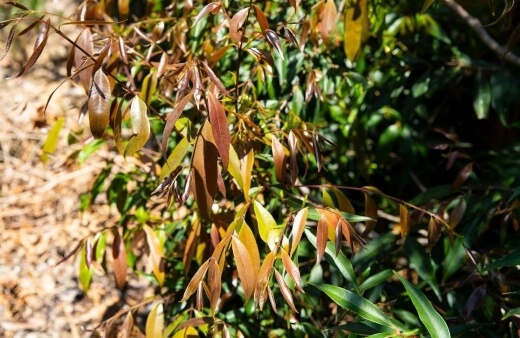If you are interested in growing a medium to large specimen tree in your landscape, the Weeping Lilly Pilly may be a fantastic option for you to consider.
This popular Syzygium species is widely planted as an ornamental tree in native gardens and larger properties where its abundant creamy blooms and glossy-green wavy-edged foliage will not only impress as a feature but will also attract local wildlife.
Here is your full guide to growing and caring for this beloved native rainforest tree.
More...
Genus: | Syzygium |
|---|---|
Species: | S. floribundum |
Family: | Myrtaceae |
Synonym: | Waterhousea floribunda |
Common name: | Weeping Lilly Pilly |
Location: | Outdoor |
Type: | Tree |
Growth: | 10 to 30 metres tall, 5 to 10 metres wide |
Sun requirements: | Full sun to light shade |
Foliage Colour: | Green |
Flower Colour: | Cream to white |
Flowering: | Summer |
Fruit: | Berries in late summer |
Maintenance level: | Low |
Poisonous for pets: | Non-toxic to cats and dogs |
About Weeping Lilly Pilly
As its name implies, this luscious evergreen tree features a gentle weeping habit with large attractive leaves and a grey, textured trunk. Blooming in summer with trusses of fragrant creamy-white, fluffy flowers followed by pale pink berries that turn red once matured, this hardy native plant is the perfect pick as a lively, low-maintenance addition to the garden.
With other nifty applications such as informal hedging or screening, this plant is a must-have for Aussie gardens with some space to fill.

Native to eastern Australia, Waterhousea floribunda (also referred to scientifically as Syzygium floribundum) is a well-known lilly pilly species commonly called weeping lilly pilly, forming a part of the Myrtales family.
Thriving in tropical to warm temperate climates, this tree can also be grown in cooler climates as long as severe frost is avoided.
Mature berries are normally ready to pick between January and April however this species of lilly pilly is not widely used as a bush tucker as there are much tastier varieties available like Syzygium australe or Syzygium luehmannii.
In the right conditions, this tree is considered fast-growing, reaching up to 30 metres tall in its natural environment and around 10 metres tall and 5 metres wide in cultivation.
Producing exciting, bright new growth and rich green foliage that grows over the full height, this is an excellent feature tree, screen, boundary marker or informal hedge plant.
Expect bees, nectar and seed-eating birds or small mammals to visit your weeping lilly pilly.
How to Grow Weeping Lilly Pilly

Source: northernbeaches.nsw.gov.au
Young and healthy tubestock plants can be purchased from local nurseries or garden centres and transplanted into your landscape where they should establish themselves quite quickly.
Alternatively, this species is swiftly propagated by seeds or by using soft-wood cuttings.


Get Your Free Guide:
Master Growing Australian Natives eBook
A Must Have Complete Guide for Every Australian Garden
Get Your Free Guide:
Master Growing Australian Natives eBook
A Must Have Complete Guide for Every Australian Garden
Waterhousea floribunda Propagation
Propagating Weeping Lilly Pilly by Seed
Seeds can be collected in late autumn from inside the berries. Each berry should contain 1 large seed which you can then dry and use for propagation. The seeds of Syzygium floribundum germinate within only 10 to 15 days given the right conditions.
- Prepare large propagation containers with quality, well-draining potting soil rich in organic matter.
- Place your seeds into the soil, burying them lightly just below the surface of your mixture. Sow multiple seeds at once for better chances of success.
- Add a small layer of your potting soil on top of the seeds.
- Water well after sowing, being sure to keep the soil lightly moist until germination.
- Place your containers in a warm, well-lit location away from harsh, direct light.
- Seedlings will need a little time to develop once they germinate before planting them in the garden. It usually takes about 6 months from sowing to planting.
- In the meantime, you can start considering ideal placement in your landscape.

Source: impressiveplants.com.au
Propagating Weeping Lilly Pilly Using Cuttings
Soft-wood cuttings from the current season’s growth can be taken in spring and should root readily, meaning you can grow a true to type plant from an existing tree.
- Using sharp and sterile garden shears, take a 20cm long cutting from a stem tip.
- Your cutting will root best if it has two or more leaf nodes or buds.
- Let your cutting dry a little then dip the planting end of the cutting into some rooting hormone.
- Place in a prepared pot filled with a quality potting mix. Equal parts peat moss, perlite and potting soil should work great. Your container must have good drainage.
- Water well after planting and place in a warm, sheltered location with bright but indirect light.
- Keep your mixture moist at all times.
- New roots and leaves should begin to develop in around 4 to 8 weeks depending on the conditions.
- Let the cutting develop for a few months before attempting to transplant it into your garden.
Our previous advice included the use of peat/sphagnum moss. However, due to its environmental repercussions, we've realigned our suggestions to highlight alternative options that are just as effective, if not better. Don't miss our comprehensive guide to learn more about peat moss and its alternatives.
Planting Syzygium floribundum
This tall, weeping tree fits in perfectly with more rainforest-themed gardens or large shaded gardens and can be long-lived in suitable conditions, often taking 3 to 5 years to reach full maturity.
For any application, these trees will grow best given certain conditions and care. Frost-free locations are ideal and planting in spring is recommended.
(See our compilation of weeping trees you will surely love to grow in your garden.)

Ideal Sunlight for Syzygium floribundum
Will grow best in full sun but also tolerates lightly shaded positions very well. Expect slower growth and less prolific flowering and fruiting in more shaded spots.
Best Soil for Weeping Lilly Pilly
This rainforest tree is well-adapted to our unique climates, being able to establish itself in many different types of soil including clay, loam or sandy loam ground. Your soil must feature sharp and consistent drainage.
Weeping Lilly Pilly Hedge & Screening Tips
If kept well maintained, you can clip these trees to around 5 metres for an attractive lilly pilly hedge. Plant 50cm apart for hedging purposes. Although this tree can make for a good hedge, there are also many other Syzygium varieties or other Australian native hedge plants that make for better hedging and screening options.
Weeping Lilly Pilly Care

Source: emeraldgardensnursery.com.au
Weeping Lilly Pilly Watering Schedule
It is recommended to water regularly until the plant has established itself which is usually 12 weeks. Thereafter, supplemental watering will be needed especially during hot and dry spells. These trees can handle a little drought but not too much.
What Fertiliser to Use
Feed with a slow-release native fertiliser every spring to encourage abundant blooms and dense new growth going into the growing seasons.
Ideal Mulching
Mulch regularly in the first 12 weeks or so as the plant establishes itself. Mulch can help the soil retain moisture in the warmer temperatures and help keep the soil stable around the tree as it grows.
Pruning Weeping Lilly Pilly
Prune once or twice a year to encourage dense new growth. If you notice leggy foliage with gaps, you will know it's time to prune. Flowers and fruits are more prolific after pruning so doing this in early spring is ideal.
For hedge pruning, you may need to be more frequent to control the shape and growth to keep the trees at a manageable height. Refer to our helpful guide on how to prune Australian native plants for more information.
Weeping Lilly Pilly Bush Tucker Tips

Source: palmnursery.com.au
As with many of the lilly pilly trees in the Syzygium or Acmena genus, the berries from this plant are considered excellent bush food and can be eaten. As mentioned earlier, other varieties produce tastier fruits like Syzygium australe or Syzygium luehmannii.
- After flowering in late summer to autumn, the fruits will start to turn from pale green to more pinkish red. This will indicate they are ripe and ready to be picked from the branches.
- The berries can be eaten fresh or cooked and used as fruit-based additions to make jams, jellies, cordials, sauces or other condiments. Fresh berries can often be too tart and sour for many people so they are often rather cooked, baked or boiled with other ingredients.
- The berries contain vitamin C and helpful antioxidants that can boost your immune system, reduce inflammation and accelerate collagen production in your skin.
- Berries will keep in the fridge for up to 3 weeks and up to 2 years in the freezer.
There are plenty of tasty recipes available online using lilly pilly berries so be sure to do some research to find something that may interest you.
Waterhousea floribunda Pests, Problems & Diseases
This hardy native tree is generally free from many issues and is considered a low-maintenance addition to the garden. However, in rarer cases, your weeping lilly pilly could fall victim to one of these problems.
Psyllids
These small, often harmless infestations can cause pimple-like spots to form on your leaves. Small attacks are fine but severe cases of psyllids should be treated by spraying your tree with neem oil or white oil regularly until the infestation has lessened.
Myrtle Rust
An inherent family disease this plant can suffer from is myrtle rust. It is a fungal disease that appears as purple spots on the leaves at first. Eventually, bright yellow spores form within these spots and fade to dull yellow and then grey as the infection ages, killing nearby foliage and severely affecting your trees’ ability to grow and produce flowers and fruits.
In mild cases, plants can be treated with specific fungicides available for the control of myrtle rust. Be sure to consult with your local garden centres or nurseries for ideal product recommendations based on your area.
In severe cases, you will need to remove and dispose of large parts of infected plants or the whole plant altogether to prevent the spread in your garden.
Weeping Lilly Pilly Frequently Asked Questions

Source: trusttrees.org.au
Does weeping lilly pilly have invasive roots?
No, this tree features a non-invasive root system so it is safe to plant near paving or other built-up structures. Just be sure to consider the growth upwards as this tree can still reach up to 30 metres tall.
What does a weeping lilly pilly look like?
It is a versatile and bushy medium to large rainforest tree with an attractive weeping habit and large wavy-edged leaves. New growth appears pink with leaves turning to various shades of green as the foliage matures.
The trunk is grey with vertical lines and cracks. It produces creamy-white and fluffy flowers in summer followed by pale green berries that turn reddish once ripe. Perfect for large screening projects or as a feature in large gardens.
Can you transplant a weeping lilly pilly?
Transplant in late winter to early spring to allow your tree to rapidly establish its roots over the warmer months.

Start Growing the Native Weeping Lilly Pilly in Your Garden
This species of lilly pilly may not make for the best hedge or produce the tastiest fruits in its genus but it offers so much more in terms of sheer beauty and its all-around attractive features.
Perfect for larger outdoor projects, this beloved native ornamental tree can easily spruce up your garden with its wonderfully textured glossy-green foliage and masses of creamy-white flowers.
Being a great choice for more formal low-maintenance gardens or more luscious, wild and native outdoor spaces, the weeping lilly pilly will fit into most Australian gardens perfectly.
Published on May 20, 2022 by Nathan Schwartz
Last Updated on February 26, 2025




